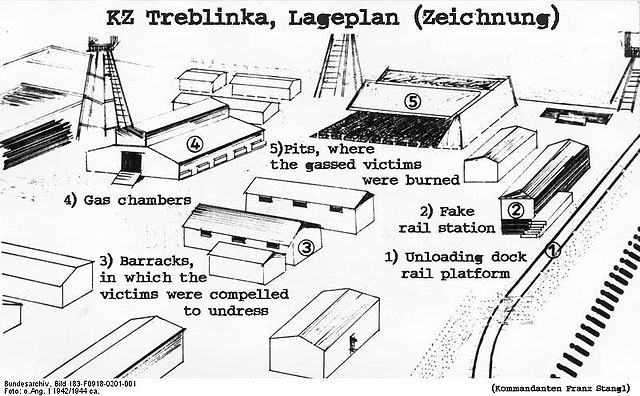 |
This is a file from the Wikimedia Commons. Information from its description page there is shown below.
Commons is a freely licensed media file repository. You can help.
|
Summary
Legend in English, based on original description supplied by the German Federal Archive added to the existing File:Bundesarchiv Bild 183-F0918-0201-001, KZ Treblinka, Lageplan (Zeichnung).jpg
| Title |
KZ Treblinka, Lageplan (Zeichnung)  |
| Original caption |
For documentary purposes the German Federal Archive often retained the original image captions, which may be erroneous, biased, obsolete or politically extreme.  |
Zentralbild/CAF
18.9.1967
Volksrepublik Polen
Das Nazi-Konzentrationslager Treblinka. - Zur Verhaftung des ehemaligen Kommandanten Franz Stangl in Brasilien
Nicht weit von der Eisenbahnstation Malkinia, nordöstlich von Warschau, liegt Treblinka, wo die Nazi-Kriegsverbrecher eines der schrecklichsten Konzentrationslager errichteten, in dem annähernd 750.000 Juden aus allen Ländern Europas vernichtet wurden. Unter härtesten Bedingungen und bei strengster Aufsicht von Nazipolozisten mußten die Gefangenen hier arbeiten.
Das Straflager Treblinka II war gerade fertiggestellt, als die Massendeportation aus dem Warschauer Ghetto begann. Eine besondere Eisenbahnstation mit Umkleidehalle wurde errichtet. Die Opfer erhielten Seife und wurden zum "Bad" geführt, in dem die Gaskammern eingebaut waren. Täglich kamen die Transporte an, die Menschen waren in Güterwagen - sogenannte Viehwagen - gepreßt, hatten weder Nahrung, Wasser noch frische Luft. Wenn sich die Transporte häuften, wurden die Opfer unter Schlägen mit Reitgerten zu den Gaskammern getrieben.
UBz: Lageplan des Todeslagers in Treblinka.
1) Auslade-Bahnsteig. 2) Eine falsche Bahnstation. 3) Baracken, in denen sich die Opfer entkleiden mußten. 4) Gaskammern. 5) Gruben in denen die vergasten Opfer verbrannt wurden.
English: (rough translation):People's Republic of Poland, September 18, 1967
Nazi concentration camp Treblinka. Concerning the arrest of the former commandant Franz Stangl in Brazil.
Not far from the Malkinia railroad station, northeast of Warsaw, lies Treblinka where the Nazi war criminals built one of the worst concentration camps, in which they murdered by industrial methods in the neighbourhood of 750,000 people. The prisoners had to work here under the hardest conditions and the strictest supervision of Nazi policemen.
Punishment camp Treblinka II was ready for operation when the mass deportations from the Warsaw Ghetto began. A special railroad station with an undressing hall was built. The victims were given soap led to the the "baths" where the gas chambers were installed. Daily the transports came in, the people were in freight cars, so called cattle cars, jammed together had neither food, water nor fresh air. When the transports backed up the victims were driven to the gas chambers under blows from riding crops.
Shown here: Camp plan of the Treblinka death camp.
1) Loading dock-rail platform. 2) fake rail station. 3) Barracks, in which the victims were compelled to undress. 4) Gas chambers. 5). Pits where the gassed victims were burned. |
| Depicted place |
KZ Treblinka |
| Date |
1942 |
| Photographer |
Unknown |
| Institution |
German Federal Archives   |
 |
| Native name |
Das Bundesarchiv |
| Location |
Koblenz (headquarters) |
| Coordinates |
50° 20′ 33.00″ N, 7° 34′ 21.00″ E |
| Established |
1952 |
| Website |
www.bundesarchiv.de |
| Authority control |
|
|
| Allgemeiner Deutscher Nachrichtendienst - Zentralbild (Bild 183) |
| Accession number |
Bild 183-F0918-0201-001 |
| Source |
 |
This image was provided to Wikimedia Commons by the German Federal Archive (Deutsches Bundesarchiv) as part of a cooperation project. The German Federal Archive guarantees an authentic representation only using the originals (negative and/or positive), resp. the digitalization of the originals as provided by the Digital Image Archive. |
|
Licensing
File usage
The following pages on Schools Wikipedia link to this image (list may be incomplete):
Wikipedia for Schools was collected by SOS Childrens Villages. SOS Children's Villages believes that a decent childhood is essential to a happy, healthy. Our community work brings families new opportunities through education, healthcare and all manner of support. Help another child by taking out a sponsorship.





